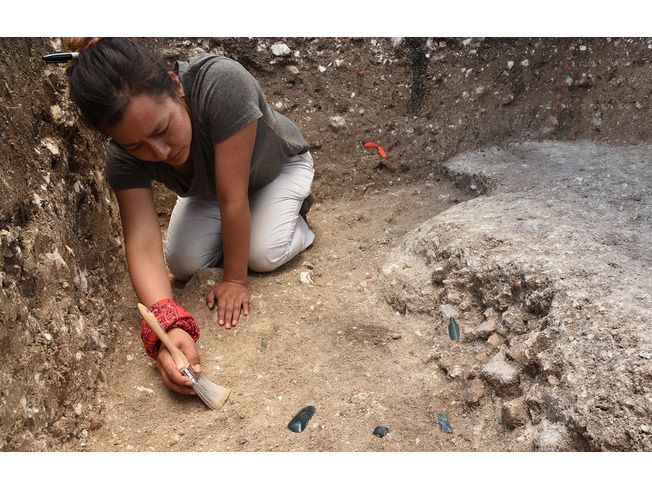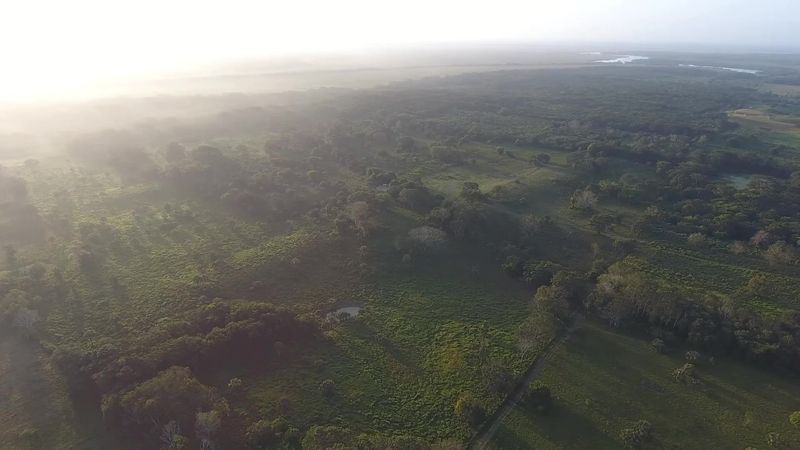Aerial Survey Identifies Oldest, Largest Maya Structure Ever Found in Mexico
The platform stands between 33 and 50 feet tall and measures almost a mile long
/https://tf-cmsv2-smithsonianmag-media.s3.amazonaws.com/filer/d8/f6/d8f6f74e-6888-45b7-9ce8-caa5ba2ca1ab/060220_bb_maya_feat-1028x579.jpg)
Among the most well-known examples of Maya architecture are the Mesoamerican civilization’s towering pyramids. But centuries prior to these iconic temples’ construction, members of the Maya culture built a larger—albeit flatter—ceremonial space. Now, aerial imaging has revealed this long-forgotten platform in Tabasco, Mexico: Built between 1,000 and 800 B.C., the structure measures more than 4,500 feet long and stands an estimated 33 to 50 feet tall, reports Will Dunham for Reuters.
According to a team of archaeologists led by the University of Arizona’s Takeshi Inomata, the platform is made up of a checkerboard of clay and earth from several different sources, suggesting that multiple communities worked together to build the mound. The area, called Aguada Fénix, is free of any sign that local royalty oversaw the project. Per Science News’ Bruce Bower, the archaeologists theorize that while local leaders may have directed construction, the work—aimed at creating a shared destination—was largely voluntary.
“We think this was a ceremonial center,” Inomata tells Tim Vernimmen of National Geographic. “[It’s] a place of gathering, possibly involving processions and other rituals we can only imagine.”
The researchers found the platform and at least nine raised roads leading to it with the help of LiDAR, which sends thousands of laser pulses toward the ground each second. By measuring how long it takes for light to bounce back to the transmitter, the technology creates a topographical map of the ground.

LiDAR is often employed in dense jungles. But Aguada Fénix was hidden in plain sight under Tabasco’s semi-forested ranch land.
“This area is developed—it’s not the jungle; people live there, but this site was not known because it is so flat and huge,” Inomata tells Kiona Smith at Ars Technica. “It just looks like a natural landscape. But with LiDAR, it pops up as a very well-planned shape.”
The platform is about nine-tenths of a mile long, a quarter-mile wide and roughly 3,000 years old, making it the “oldest monumental construction ever found in the Maya area and the largest in the entire pre-Hispanic history of the region,” write Inomata and his colleagues in the journal Nature. The size of the structure and nearby evidence of corn cultivation indicate that the people responsible for building Aguada Fénix were starting to transition from a hunter-gatherer lifestyle to a stationary community.
“The sheer size is astonishing,” says Jon Lohse, an archaeologist at Terracon Consultants Inc. who wasn’t involved in the study, to National Geographic.
Lohse disagrees that the structure is suggestive of a community settling in one place.
“Monumental constructions by pre-sedentary people are not uncommon globally,” he adds.

Aguada Fénix was built over the course of 200 years, with construction completed by 800 B.C. But the platform was abandoned just 50 years later, according to Ars Technica. While small groups may have used the ceremonial site in the centuries afterward, these gatherings were a far cry from the crowds that would have convened during the platform’s prime.
“It is probable that many people from surrounding areas gathered for special occasions, possibly tied to calendrical cycles,” Inomata tells Reuters. “The rituals probably involved processions along the causeways and within the rectangular plaza. The people also deposited symbolic objects such as jade axes in the center of the plateau.”
The team’s discovery disputes the theory that Maya society developed from small villages into increasingly larger urban centers. The site lacks a city center but could have been built by 5,000 people in about six years, reports National Geographic.
While a nearby civilization, the Olmec, created similar structures prior to the Maya, these platforms usually included large stone sculptures of rulers. Surveys of the Aguada Fénix platform revealed pottery, bones and shells, but no sign of the kind of statues that would hint at a ruling class.
“The public spaces at Aguada Fénix are huge,” says Brown University archaeologist Andrew Scherer, who wasn't involved in the study, to Science News. “And there is nothing to indicate that access was limited to a privileged few.”